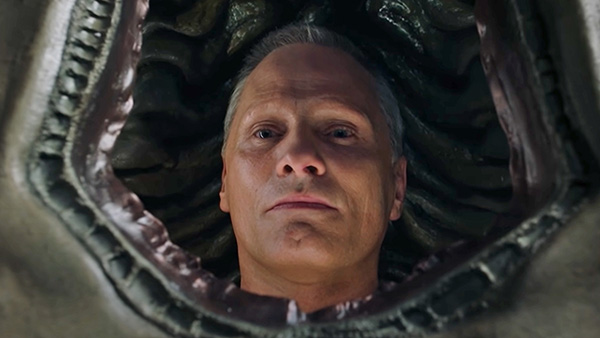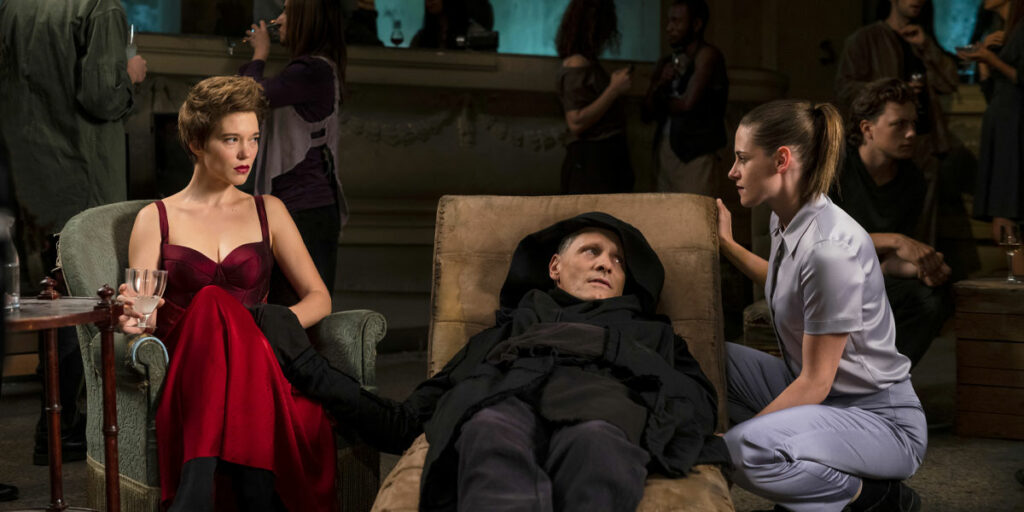Crimes of the Future finds David Cronenberg back to directing genre fare for the first time in over two decades, but this “comeback” leaves a bit to be desired.
By this point in his career, David Cronenberg has little left to prove. He has a few indisputable classics under his belt (The Fly, Videodrome, etc.) and he’ll go down in history as one of the originators of the “body horror” subgenre (you’ll find few – if any – auteurs working in “body horror” today who don’t credit Cronenberg with kick-starting their fascination with that style of cinematic horror). And that’s why, given that he hadn’t made a movie since 2014’s Maps to the Stars, it wouldn’t have been absurd for one to assume that Cronenberg had retired completely, content with the career he’d had and the way he’d made a change in the medium. However, there was one unproduced project that kept following him all these years – call it, “the project that got away” – and that was the script that would eventually become this year’s Crimes of the Future.
Originally titled Painkillers, the film was set to begin production in 2003, with Nicolas Cage – and later, Ralph Fiennes – in the lead role, but plans ultimately fell through, and Cronenberg would then never return to the sci-fi or horror genres following 1999’s eXistenZ. Flash forward to 2021, and it was revealed that, after revitalizing his interest in the project and refining the script, Cronenberg was making Painkillers – now called Crimes of the Future – at long last, with Viggo Mortensen in the lead and Léa Seydoux and Kristen Stewart co-starring.
And through it all, Cronenberg has been able to keep his story mostly the same. In a not-so-distant future, as mankind strains to adapt to its “synthetic surroundings,” some start to develop the ability to produce new organs, such as performance artist Saul Tenser (Mortensen), who has these organs removed in avant-garde performances by his partner Caprice (Seydoux). However, a new governmental group called the National Organ Registry starts to interfere with their art and track their movements – with this mission led by the meek Timlin (Stewart) – while a rogue underground crew also has Tenser in their crosshairs, aiming to make a social statement through his “art.”

The one thing that’s never up for debate with Cronenberg is the man’s ability to make a masterfully crafted movie – his style simply speaks for itself. Few can cultivate mood and atmosphere like the auteur, and, as such, Crimes of the Future’s biggest calling card is its wondrously intricate world-building, enhanced by Cronenberg’s distinguished direction, Douglas Koch’s consuming cinematography, and Howard Shore’s startling score. Regardless of how invested you may be in the actual story here, it’s impossible to not be immersed in the environments Cronenberg envisions.
Each scene is set up with so much care and consideration that it’s as if each is a short film in and of itself, containing more than enough detail to support a story on its own. It’s clear that the two decades that have passed since Cronenberg first dreamed up this torrid tale have allowed him to flesh out the particulars of his vision of our frightening future, and as a result, the aesthetic textures feel truly tangible – it’s as if we too can inhabit these intimidating interiors, stepping through the screen and standing alongside Saul and Caprice and co. Solely from a visual standpoint, Crimes of the Future is sumptuous and stupefying.
Where this sordid saga stumbles is with its storytelling. One hesitates to label any plot thread as unnecessary or uninteresting – because Cronenberg sincerely does put forth some compelling ideas here about humankind’s continued (and catastrophic) reliance on artificial and technological assistance, a post-pain society, and alternative approaches to sex – but it also feels like his attention is too divided, and no storyline receives the full focus it deserves. In many ways, Crimes of the Future feels more like a TV pilot than a full-length feature film; it seems as if each subplot is headed towards a richer resolution, but there’s not enough room to explore all of them in their entirety here, and when the film ends, multiple arcs are left up in the air, and we’re missing a true third act – or an entire season of TV – to do them justice and tie all of Cronenberg’s themes together.
Scene-to-scene, Crimes of the Future is mightily captivating, thanks to the aforementioned arresting aesthetic and propulsive performances from most of the ensemble (Seydoux is the standout, seductive yet suspicious, while Mortensen leans into Saul’s “goth” disposition with glee, and only Stewart doesn’t blend in as well as her co-stars, struggling to root Timlin in this reality), but in the end, it’s less than the sum of its parts.
There’s a lot to love with Crimes of the Future, and Cronenberg devotees will delight in his dense world-building and brutal yet beautiful body horror (even if it does feel like he could’ve gone even a bit further with the gore), but for those not already enamored with his signature style, it’s likely that the story here will leave a bit to be desired, with too scattered a structure to satisfy. Come for Cronenberg’s ferocious view of our future and a standout supporting performance from the always-reliable Léa Seydoux, but if you’re searching for the second coming of The Fly or Videodrome – or even Crash or Scanners – know that Crimes of the Future doesn’t quite touch top-tier Cronenberg when all is said and done, despite some fleeting moments of fear and fun to be found here and there.
Crimes of the Future is now available to watch on digital and on demand. Read our review of Cronenberg’s Spider (2022)!

